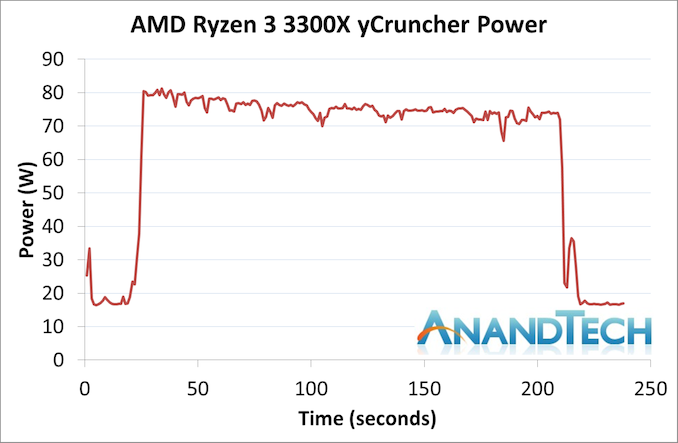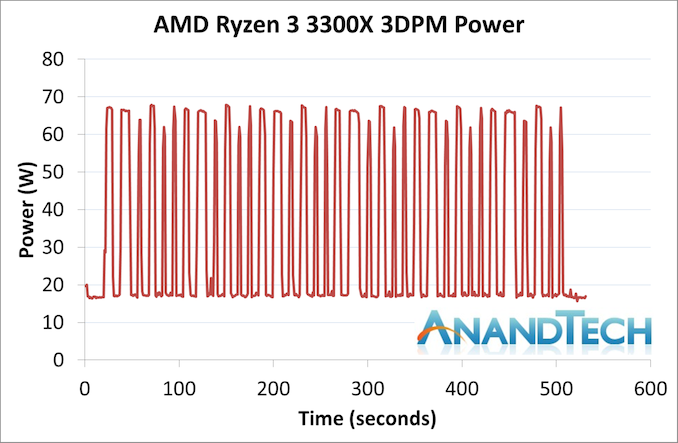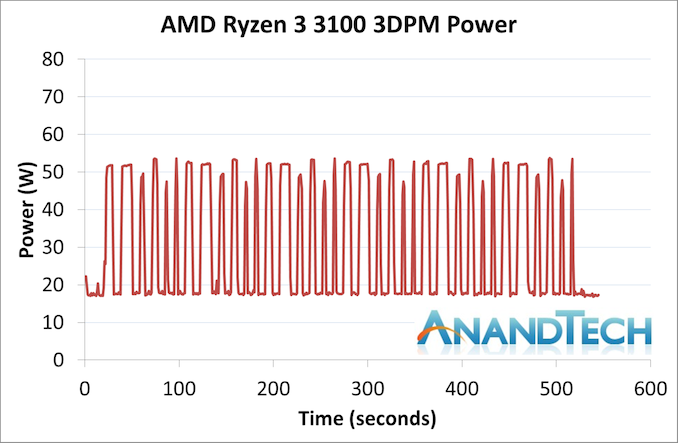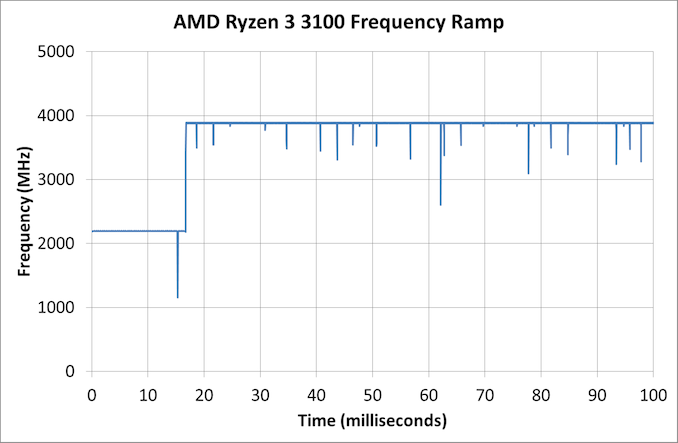The AMD Ryzen 3 3300X and 3100 CPU Review: A Budget Gaming Bonanza
by Dr. Ian Cutress on May 7, 2020 9:00 AM ESTPower Consumption and Frequency Ramps
On the box, both processors are listed as having 65 W TDPs. With its Zen-based hardware, AMD has been relatively good at staying around that official on-the-box value, even during turbo. In the last generation, AMD introduced a feature called PPT, or Package Power Tracking.
- For 105 W processors, PPT is >142 W
- For 65 W processors, PPT is >88 W
- For 45 W processors, PPT is >60W
This allows the processor to raise its power limits, assuming it isn’t breaching thermal limits or current limits, and consequently raise the frequency. As a result, while we see 65 W on the box, the real world power consumption during most tasks is likely to be nearer 88 W, unless the current or thermal lines are crossed.
As a new element to our testing, we are recording power over a number of benchmarks in our suite, rather than just a simple peak power test.
AMD Ryzen 3 3300X
For the faster chip, we saw a peak power in both of our tests of around 80 W.
With yCruncher, which is somewhat of a periodic load, the power consumption dropped over time to nearer 75 W.
3DPM is more obvious with its idle steps between loads, being 10 seconds on then 10 seconds waiting. The power almost peaked at a similar amount here.
In both of these graphs, the package power when idle is around 16-17 W. I looked back through the data, and noticed that out of this power only 0.3 W was actually dedicated to cores, with the rest being towards the big IO die, the memory controllers, and the Infinity Fabric. That’s still pretty substantial for an idle load.
At low loads, the power per core was around 14 W, while at full load it was slightly less depending on the test. This is a bit away from the 20 W per core we get from the high end Zen 2 processors, but these only go to 4.3 GHz, not 4.7 GHz+. This is about in line with what we expect.
On our frequency ramp test, the Ryzen 3300X went from an idle state to peak power within 17 milliseconds, or approximately a frame at 60 Hz.
One of the new features with Ryzen 3000 is CPPC2 support, which AMD claims to reduce idle-to-turbo ramping from 30 milliseconds to 2 milliseconds. We’re seeing something in the middle of that, despite having all the updates applied. That being said, the jump up to the peak frequency (we measured 4350 MHz, +50 MHz over the turbo on the box) is effectively immediate with zero skew across a range of frequencies.
AMD Ryzen 3 3100
Given that the TDP number on the side of the box says 65 W as well, any reasonable user would assume that the power of this chip would be equal, right? Regular readers will know that this isn’t always the case.
In our yCruncher test, because the turbo frequency is lower than the 3300X, it means the voltage can be lower, and thus power is lower. Our history of testing Zen 2 has shown that these cores get very efficient at lower frequencies, to the point where our processor doesn’t even break that 65 W threshold during yCruncher.
Similarly the 3DPM peaks are also lower, barely going to 55 W during an AVX2 workload.
On the frequency ramp side, we see another instance of a 16-17 ms transition.
Summary
For the peak power out of all of our testing, we saw the Ryzen 3 3300X hit a maximum of 80 W, and the Ryzen 3 3100 go to 62 W. When we compare that to the Core i7-7700K, at 91 W TDP / 95 W peak, combined with most of the results on the next few pages, AMD by comparison is more efficient.
















249 Comments
View All Comments
PeterCollier - Friday, May 8, 2020 - link
I'm expressing my informed opinion, what's your issue?Korguz - Friday, May 8, 2020 - link
informed opinion ?? yea rightDeicidium369 - Friday, May 8, 2020 - link
Don't mind Korguz - he never offers anything to the conversation... the is a hard core AMD shill who thinks he makes his point by calling other people Intel shills. He is a bit creepy - he will follow you on multiple forums...Just ignore him - he has nothing.
Korguz - Friday, May 8, 2020 - link
and you can also ignore Deicidium369, he cant get is OWN personal facts straight, and also gives false information on another site, so anything he says are lies, and BS calls me a hardcore amd shill, but yet, says NOTHING positive about amd, but praises intel like a god, go figure" He is a bit creepy - he will follow you on multiple forums... " FYI there are others that know about your other post that are full of mis information, and call you out on it to, and your response, just like here, name calling, insults, and condescending remarks, this is why you were banned from tom's, was it not ?
Korguz - Friday, May 8, 2020 - link
" Just ignore him - he has nothing. " oh i do, do " ?take a look that these 2 pics here :
in the 1st pic, he states he retired @ 28, 20 years ago( year 2000 ), then a few days later claims he started, and built up a complete woodshop business 40 years ago, which using his " retired at 28 " BS, as a reference, would of made him EIGHT years old. so either he is a lier, or he cant get his facts straight. the only reason to listen to him, is cause his posts are comedy gold
i wonder what BS he will type for this now
Korguz - Friday, May 8, 2020 - link
https://imgur.com/a/s9Ift1pPeterCollier - Saturday, May 9, 2020 - link
Thanks, I'll make a mental note to ignore him.Spunjji - Monday, May 11, 2020 - link
This comment is absolutely hilarious. Korguz mocks PeterCollier for accusing Ian and AnandTech of anti-Intel bias, and Deicidium369 chimes in saying it's because... *drumroll* Korguz is a "hard core AMD shill". Even better is that PeterCollier goes on to agree.Peter and Deicidium make a great pairing - two sides to the same demented coin.
PeterCollier - Monday, May 11, 2020 - link
Your obsession with certain posters is concerning.Spunjji - Tuesday, May 12, 2020 - link
🥱